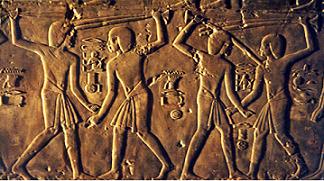|
|
|
|
|
|
|
 |
 |
|
THE AFRICAN CONTINENT is rich in
history and it is perhaps not surprising that it boasts one of the oldest
martial arts in existence. Its varied landscape—the massive expanses of
deserts, the lush green jungles, and the amazing vistas and fauna—is
reflected in the diversity of its martial arts, which, along with those of
the Middle East and central Asia, are arguably among the most captivating in
the world.
|
 |
The earliest evidence
of martial arts in Africa was discovered in the Beni Hasan tombs in Egypt,
which date back to between 2040 and 1785 BCE, during the Middle Kingdom. In
the tombs, archaeologists found paintings of wrestlers displaying techniques
such as punching, kicking, throwing, and locking of their opponents’ joints.
There is also evidence to suggest that ancient Egyptians performed stick
fencing as a tribute to the Pharoah.
Modern Egyptian Stick Fencing—the highly
codified system of combat with its own methodology, weaponry, and training
syllabus—was developed to keep the Egyptian armed forces trained and ready
for battle. |
|
Wrestling and grappling arts are popular throughout Africa and have been
likened to European Catch Wrestling and
Pankration. These were traditionally associated with
agricultural ceremonies and courtship rituals, most commonly in Nigeria,
Sudan, Senegal, Cameroon, and the Gambia.
Tribal arts
Tribal fighting arts were originally practiced as a method of survival
because, prior to colonization, the greatest danger to sub-Saharan Africans
was the threat from other tribes. Tribal rivals would have been equally
matched as hunters, gatherers, and fighters. The most renowned of the
African warrior tribes was the Zulu of South Africa, who still represent
South Africa’s largest ethnic group. Historically, their primary arts
included the spear, shield, and club, and they made clever use of all three
during strategic advancement.
|
 |
African
Weapons
African tribal weapons were designed for
warfare and survival and, as such, were brutal. Historically, the Zulus(South
African)
initiated combat by first throwing their spears from a distance or charging
at opponents with them, using their shield as a blocking device. When the
use of a spear became impractical at close quarters, they would switch to a
club. However, Shaka Zulu(South African Zulu King), the revolutionary leader of the Zulus during the
early 19th century, changed indigenous warfare when he introduced the
“iklwa,” a stabbing spear that proved highly effective in combat when
combined with a tall shield.
Many other clever instruments of war were developed in Africa. The throwing
iron, for example, known as the “mongwanga,” was a spiked weapon throwing
implement that could be employed effectively from distances of 82 yd (75 m).
When thrown with force at a closer range of 27 yd (25 m), this multi-bladed
instrument could easily impale a victim, sometimes with lethal consequences.
It also had a handle so that it could be used to stab and thrash at close
quarters. Another interesting weapon used by certain tribes was the bladed
bracelet – a wrist bracelet with a sharpened outer edge.
|
Dance and music
Perhaps the most interesting aspect of early African martial arts was the
reliance on memorizing attacking and defensive maneuvers by setting them to
patterns of dance, accompanied by music. These artistic elements of African
martial arts have also influenced other arts, such as
Capoeira, the
Brazilian dance- and music-based martial art, which was originally practiced
by African slaves. |
 |
|
Colonization and
change
Throughout Africa’s long history, martial arts have largely remained
unchanged until relatively recently. From the mid-18th century, the European
introduction of firearms in exchange for West African slaves threatened the
continuation of traditional martial arts in Africa. The introduction of the
gun changed the face of warfare entirely, leading to an emphasis on
different battlefield skills. Furthermore, in the late 19th century, the
Islamic revitalization of many African countries led to the reduction of a
lot of martial arts that contained pagan or shamanic elements. |
|
|













